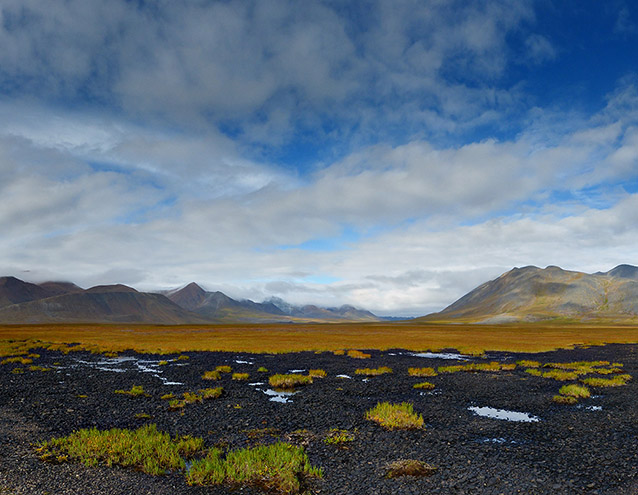The primary mandate given by the Wilderness Act of 1964 is to preserve wilderness character. Wilderness character is the essence of the landscape—a holistic concept based on the interaction of (1) biophysical environments primarily free from modern human manipulation and impact; (2) personal experiences in natural environments relatively free from the encumbrances and signs of modern society; and (3) symbolic meanings of humility, restraint, and interdependence that inspire human connection with nature. Taken together, these tangible and intangible values define wilderness character and distinguish wilderness from all other lands (Landres et al. 2015).

NPS Photo / Nyssa Landres
To help land managers fulfill this mandate, a framework for monitoring wilderness character was developed and is in the process of being implemented across the U.S. This framework applies to Arctic Alaska in the same way it does to the rest of the country; it uses the same protocols to describe and monitor wilderness character, and provides the same benefits to wilderness stewardship and management efficacy.
Using this framework, the Noatak Wilderness in the western Brooks Range of Arctic Alaska recently completed a Wilderness Character Narrative that describes the area’s holistic and often intangible wilderness character. A Wilderness Character Monitoring Baseline Assessment was also completed that describes how we will monitor wilderness character for the Noatak Wilderness. These management documents acknowledge the exceptional setting of Arctic wilderness, helping managers to more fully understand and effectively preserve the area’s unique wilderness character.
When applying the wilderness character framework to the Noatak Wilderness, managers made several special considerations, including three primary factors that need to be addressed when monitoring Arctic wildernesses. First, the vast cultural significance and resources of these places, many of which continue to be used to this day, must be acknowledged as an integral part of wilderness character. To do this, the Noatak Wilderness incorporated “Iñupiat Homeland” as a quality of wilderness character to recognize the tangible and intangible cultural values of the Noatak’s wilderness character. Second, wilderness character monitoring must address the provisions provided in the Alaska National Interest Lands Conservation Act of 1980 (ANILCA) and how they work in conjunction with the Wilderness Act. For instance, it is important to understand how motorized uses allowed under ANILCA (such as fixed-wing aircraft and motorboats, among others) negatively affect wilderness character, while recognizing that these uses will continue to occur in wilderness. The Noatak Wilderness addressed these provisions by devising strategies to monitor legal motorized uses, thereby allowing managers to better understand their patterns of use and tailor management actions accordingly. Third, creative solutions must be found to account for gaps in the quantifiable data by which wilderness character monitoring is typically conducted. We generally avoid duplicating monitoring and research efforts by using data collected by other programs, but many existing datasets do not include the Arctic. To address these difficulties with data acquisition, Noatak staff worked to identify measures that would accommodate the use of short-term datasets and isolated research projects. For example, some measures provided guidelines for using professional judgement to assess specific wilderness resources in lieu of the long-term data that are typically available for other wilderness areas.
Managers who are tracking change in wilderness character in the Arctic face many challenges, and this monitoring framework is flexible enough to overcome these challenges to meet stewardship needs. Ultimately, the Noatak’s Wilderness Character Narrative and Wilderness Character Monitoring Baseline Assessment provide a comprehensive depiction of the area’s wilderness character, allowing managers to more effectively meet the stewardship needs of the Noatak Wilderness into the future.
Reference
Landres, P., C. Barns, S. Boutcher, T. Devine, P. Dratch, A. Lindholm, L. Merigliano, N. Roeper, and E. Simpson. 2015.
Keeping it Wild 2: An Updated Interagency Strategy to Monitor Trends in Wilderness Character Across the National Wilderness Preservation System. USDA Forest Service, Rocky Mountain Research Station, General Technical Report RMRS-GTR-340, Fort Collins, CO.
Part of a series of articles titled Alaska Park Science - Volume 16 Issue: Science in Alaska's Arctic Parks.
Next: The Fate of Permafrost
Last updated: March 6, 2017
